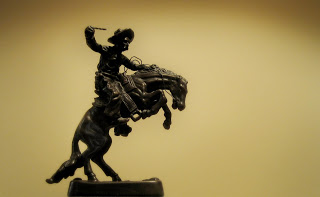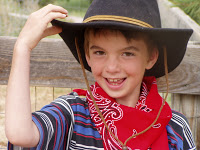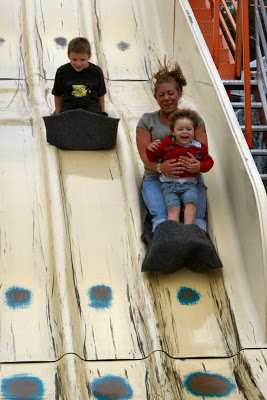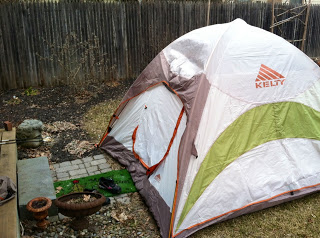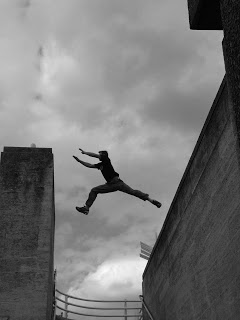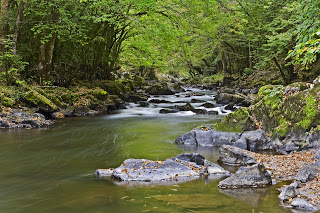Author Archives: admin
Plan B
Making Friends with Fear
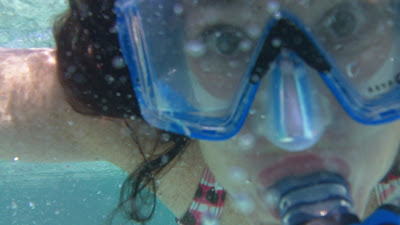 |
| Me making friends with Fear |
As some of you dear readers may recall, I decided to adopt a fearless approach to life in 2012. Trust me, co-writing a blog about nurturing courage in kids will force you to examine (in depth) the ways you may be both the brave and cowardly lion. Since I also currently treat both children and adults with anxiety, I thought it especially important to put into practice some of the approaches I’ve been encouraging my patients to adopt. Taylor Clark’s new book Nerve: Poise Under Pressure, Serenity Under Stress, and the Brave New Science of Fear and Cool (2011) also woke me up a little.
 I was in the
I was in the
I did lecture my kids later about the importance of sticking to our promise to stay where we leave them. As a parenting coach, I’m particularly aware of those times when we can lash out at our kids because we are afraid or when we’ve made a mistake and are looking for a scapegoat. Like the moment after our child lets go of our hand and jumps off the sidewalk curb, only to narrowly miss being hit by a car, and we pull them back into our care only to berate them for their foolishness instead of saying, “Oh, sweetie! I’m so grateful you are okay.” I’ve learned to make a sincere effort with my kids, especially when I’m feeling fear, to hug first (while taking a deep breath) and lecture last. In other words, connect then correct!
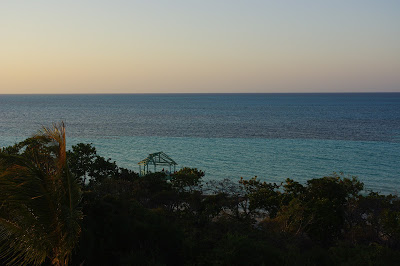 So, a few weeks ago in the midst of an East Coast winter storm, the
So, a few weeks ago in the midst of an East Coast winter storm, the
Well, embarrassing as this is to admit, I actually hadn’t asked myself that one important question. Truth be told, I don’t really want to become a scuba diver. It was more of a pride thing after the snorkeling debacle. A vague interest that sounded cool to try someday. And I still might, with a lot more preparation and time than I had for this particular trip. But I did want to get back in the water and learn to snorkel more confidently alongside my very observant children who have enjoyed teasing me over the past few years since my “
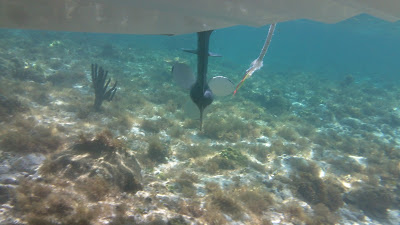 |
| My views of the coral reef
Pacific Red Lion Fish |
I’m happy to report that last week, despite malfunctioning equipment and needing to repeatedly tell my family to chill out and let me go at my own pace, I did get back into snorkel gear and swam atop a pristine coral reef in the Caribbean–albeit very close to our guide’s boat. It took a few minutes for me to adjust my breathing, as my brother had explained is normal (normalizing stuff always makes me feel better). I also needed to make sure my kids were being well taken care of by their father and a guide, so I could calmly explore on my own. But once I gained comfort in my new underwater surroundings, I marvelled at the sea life all around me. Schools of fish swimming right up to my mask to say “Hello!” and grab some of my offerings of food. Stingrays gliding by, thank you very much. And the serene coral beds waving their friendly, albeit deceptive, greetings. The salt to water content in this particular ocean playground is so high, it was easy just to float and relax both my body and mind–a big part of offsetting panic. In fact, I gained so much confidence facing my fear that I even decided to take on another courage challenge and held a couple of alligators that same week.
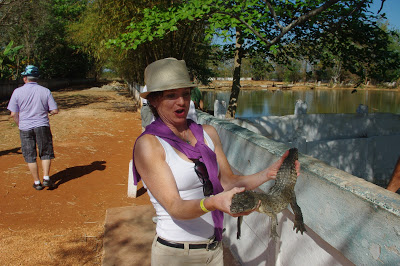 |
| Me and a two-month old gator |
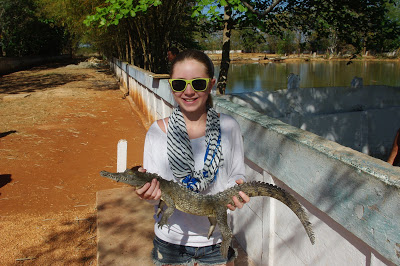 |
| My “much more confident, relaxed” daughter with the same gator |
What fear do you want to make friends with and grow a little courage along with me in 2012? What about your son or daughter?
Courage Challenge Report: Dealing with Dragons
Amazingly, she reported a dream to me when she woke up – a dream so perfect to the occasion that a screenwriter or novelist could not have done better. “I was in a town, and the next town over was destroyed and deserted because there was a dragon. And people had to get picked to go there and be sacrificed so it wouldn’t come destroy this town too. And I got picked, and L., (one of her best friends) and we went there and there was a volcano where it lived. There were tracks and the old mining car things, like a roller coaster, and we got in one of those cars. We had a blue snake with us – I think it was a magical snake. And we didn’t want to go near where the dragon was. We saw a pit full of dead bones. The tracks were going up and down and were broken in some places, and the car thing we were in had to jump over gaps. Then ahead of us was this wall — like water standing up – and we had only a certain time left to get through it before it turned to stone and the dragon wouldn’t be able to get us. Then that snake that was with us was the dragon. But it couldn’t get through the wall. And we were safe.”
In the words of Joseph Campbell: “The cave you fear to enter holds the treasure that you seek.”
.
The fear at the bottom of the hole
It has been argued that there is, fundamentally, only one fear: the fear of death. This hypothesis says that if you trace any fear to its deepest, darkest root, it turns out it’s the fear of nothingness, of non-being, our mortality. But I recently came across a very inspiring passage from How To Write a Sentence and How to Read One, by Stanley Fish (and yes, I read books like this!) that offered me a new insight into this fear.
“Mortality is the condition of being able to die, regarded by many as a curse, but more properly appreciated as a gift, the gift of design and choice, of gain and loss, of hope and desperation, of failure and redemption, all modes of being that are available only to creatures who, like sentences (and novels), have a beginning, a middle, and an end. It is the inevitability and shadow of death that provides life with a narrative arc, and provides moments in that narrative with a meaning; for the meaning of a moment – the distinctiveness – is a function of the place prepared for it by a past and the place waiting for it in a future…Without the specter and period of death, there would be no urgency of accomplishment, no expectations to be realized or disappointed, no anxieties to be allayed. Each moment would bear an equal weight or equal weightlessness.” (p 154)
Ask yourself: without fear, can you have courage?
.
Parkour? Or Peace Like a River?
5-Minute Courage Workout: Pull Up a Chair and Make Yourself Uncomfortable!
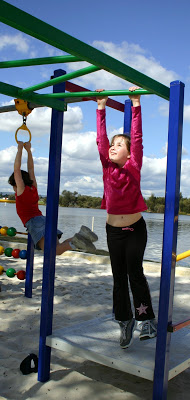 Part of developing physical courage is to gain, through experience, a comfort with discomfort. It is impossible to know one’s physical limits and/or capacity without testing them. It is through conquering our fears of high places, being cold, underwater, fatigued, thirsty, or whatever particular physical discomfort we may have, that we have the opportunity to boost our physical courage capacity. It is through confronting physical discomfort and pushing through pain, that we can learn (and teach our children) that we have the capacity to survive situations that may someday truly test our limits. Our assumed limitations often have as much to do with the story we tell ourselves about our physical discomfort as any actual physical limitation. Pushing ourselves just that little bit past our usual comfort zone can often reveal surprising strength.
Part of developing physical courage is to gain, through experience, a comfort with discomfort. It is impossible to know one’s physical limits and/or capacity without testing them. It is through conquering our fears of high places, being cold, underwater, fatigued, thirsty, or whatever particular physical discomfort we may have, that we have the opportunity to boost our physical courage capacity. It is through confronting physical discomfort and pushing through pain, that we can learn (and teach our children) that we have the capacity to survive situations that may someday truly test our limits. Our assumed limitations often have as much to do with the story we tell ourselves about our physical discomfort as any actual physical limitation. Pushing ourselves just that little bit past our usual comfort zone can often reveal surprising strength.
Here’s a list of 5-Minute Courage Workouts by age range to help you and your child to develop some comfort with physical discomfort:
- Toddler: the next time you are hanging out together on the jungle gym, taking a walk, or tumbling in gymnastic class, see if you can create an opportunity to push yourselves just a little bit harder, just a little bit longer. When your child says “I can’t. I want to be carried,” see if you can coach him/her to build some endurance with the play. Promise, “Let’s just play for 5 minutes more, and then we will take a break. I know you can do it!”
- Preschooler: the next time you are headed out on a wintery walk, let your child choose if he/she will wear a coat. Pack the coat along with you, just in case. After 5 minutes or so on the walk, ask your child “Do you feel cold enough to need your coat?” Let them have the experience of needing to wear the coat, instead of just assuming or wanting that for them.
- Early elementary student: ever been drenched in a rainstorm or fallen overboard? Uncomfortable isn’t it, to be walking or swimming around in water-soaked jeans. How about simulating such an experience for your child by encouraging them to take a bath tonight fully clothed? See if they can stay in the tub or shower for 5 minutes in their soaking wet, heavy clothing!
- Upper elementary student or ‘tween: have a sit-up challenge with your child tonight. Before heading to bed, ask your child if they would like to see how many sit-ups you both can do in 5 minutes. You can do them as slowly or quickly as you want. Teach them how to do a sit-up, if they don’t know how, or google how to do one effectively if it has been awhile. The goal is to experience the pretty much immediate discomfort and encourage one another to push through that feeling until the timer goes off.
- High schooler or teen: The next time your teen goes to raid the fridge, ask “Are you hungry? How do you know you’re hungry?” Have a 5-minute discussion with your child about the difference between craving and hunger. Sometimes we crave sugar and simple carbohydrates, when our bodies really need a muscle and brain building protein-enriched meal. Sometimes we are hungry for time, attention, rest, or human connection, more than we are for food. Sometimes out of emotional discomfort, we hope food will fill the void. True hunger is different. A discussion like this can also help us develop compassion for what it might be like to be truly hungry due to poverty or famine and to develop gratitude for the food that we do have in our fridge. Pausing before eating can also help develop tolerance for being “just a little bit hungry” and still being okay when we can’t immediately satisfy every craving.
We love to hear your stories!
Here are some other 5-Minute Courage Workouts to tackle physical courage:
Playing With Fire, Navigating the Neighborhood, Talking Dirty, It’s a Dog Eat Dog World.
On Stories, Narrative and Storytelling
This again is from Bruce Jackson’s wonderful The Story is True: The Art and Meaning of Telling Stories, and speaks to our human urge to reframe our experiences into coherent narratives so that we can understand what happens to us and around us:
“When we can’t figure out the plot in real life, people say, ‘It’s senseless, just senseless.’ And that may be true; it may be senseless. Sense is a product of our intelligence, not a condition of the world. But few of us are satisfied with ‘it’s senseless’ as an explanation. We want bottom lines. We want villains and conspiracies and plots like those in movies and novels; we want to live in a causal universe, a universe in which things make sense.”
Courage Question of the Day
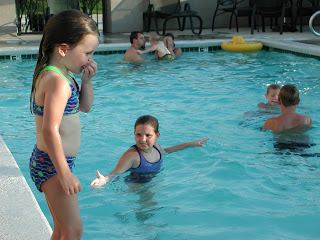 Physical courage is the one type, from the Six Types of Courage, that most people think of first. It is the type of courage that allows us to risk discomfort, injury, pain or even death—running into burning buildings as a firefighter, facing an enemy on the battlefield, undergoing chemotherapy, climbing a mountain, protecting a child from a dangerous animal. We are right to be wary of pain: pain tells us where our boundaries and limits are. However, sometimes there are things more important than pain, and our physical fear becomes a border to be crossed. Physical fear is often blown entirely out of proportion: pain is often greater in anticipation than in fact, and that dread can become an insurmountable barrier. Physical courage also involves recognizing that your body is how you participate in the world; keeping it healthy, strong, and resilient prepares you for all kinds of challenges, not just physical ones.
Physical courage is the one type, from the Six Types of Courage, that most people think of first. It is the type of courage that allows us to risk discomfort, injury, pain or even death—running into burning buildings as a firefighter, facing an enemy on the battlefield, undergoing chemotherapy, climbing a mountain, protecting a child from a dangerous animal. We are right to be wary of pain: pain tells us where our boundaries and limits are. However, sometimes there are things more important than pain, and our physical fear becomes a border to be crossed. Physical fear is often blown entirely out of proportion: pain is often greater in anticipation than in fact, and that dread can become an insurmountable barrier. Physical courage also involves recognizing that your body is how you participate in the world; keeping it healthy, strong, and resilient prepares you for all kinds of challenges, not just physical ones. Do you think it takes more physical courage to climb a mountain or battle an illness? Do you think it takes more courage to learn to sleep in the dark, take your first steps, or try diving off a diving board for the first time? Do you notice a difference between your son and your daughter, in terms of how they define physical courage and what it looks like in their lives?
Can you remember a time that you or your child had to have physical courage? Please post your thoughts or stories here.
We would very much appreciate hearing from you!
.
About Stories
From a wonderful book called The Story is True: The Art and Meaning of Telling Stories, by Bruce Jackson. It says so elegantly what we’ve said before in Sharing Family Stories and other posts.
“In time, how we tell our story depends not so much on what happened then, but on what we know of the world now. And that is why the story of that time told at this moment means at least as much, and perhaps more, about this world now than that time then. And that is why these stories we tell again and again remain forever new.”
